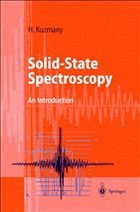Nicht lieferbar

Solid-State Spectroscopy
An Introduction
Versandkostenfrei!
Nicht lieferbar
Weitere Ausgaben:
Spectroscopic methods have opened up a new horizon in our knowledge of solid-state materials. Numerous techniques using electromagnetic radiation or charged and neutral particles have been invented and worked out to a high level in order to provide more detailed information on the solids. In this text, new radiation sources like lasers and synchrotrons are discussed. It provides a description of the linear response together with the basic principles and the technical background for various scattering experiments. Fourier transform spectroscopy, pulsed and magnetic NMR techniques, photo-emissio...
Spectroscopic methods have opened up a new horizon in our knowledge of solid-state materials. Numerous techniques using electromagnetic radiation or charged and neutral particles have been invented and worked out to a high level in order to provide more detailed information on the solids. In this text, new radiation sources like lasers and synchrotrons are discussed. It provides a description of the linear response together with the basic principles and the technical background for various scattering experiments. Fourier transform spectroscopy, pulsed and magnetic NMR techniques, photo-emission, and light and electron scattering are elucidated. Each chapter includes problems. The concept of this textbook is designed for graduate students.
Table of contents:
1. Introduction, 2. Electromagnetic Radiation, 3. Light Sources with General Application, 4. Spectral Analysis of Light, 5. Detection of Electromagnetic Radiation, 6. The Dielectric Function, 7. Spectroscopy in the Visible and Near-Visible Spectral Range, 8. Symmetry and Selection Rules, 9. Light Scattering Spectroscopy, 10. Magnetic Resonance Spectroscopy, 12. Ultraviolet and X-Ray Spectroscopy, 13. Spectroscopy with y Rays, 14. Generalized Dielectric Function, 15. Spectroscopy with Electrons, 16. Spectroscopy with Positrons and Muons, 17. Neutron Scattering, 18. Spectroscopy with Atoms and Ions, Appendices A-M
Table of contents:
1. Introduction, 2. Electromagnetic Radiation, 3. Light Sources with General Application, 4. Spectral Analysis of Light, 5. Detection of Electromagnetic Radiation, 6. The Dielectric Function, 7. Spectroscopy in the Visible and Near-Visible Spectral Range, 8. Symmetry and Selection Rules, 9. Light Scattering Spectroscopy, 10. Magnetic Resonance Spectroscopy, 12. Ultraviolet and X-Ray Spectroscopy, 13. Spectroscopy with y Rays, 14. Generalized Dielectric Function, 15. Spectroscopy with Electrons, 16. Spectroscopy with Positrons and Muons, 17. Neutron Scattering, 18. Spectroscopy with Atoms and Ions, Appendices A-M



